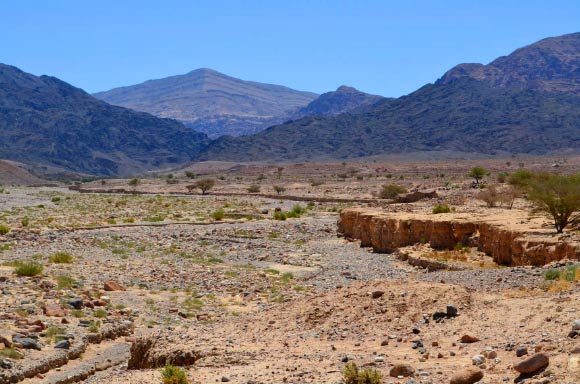A research team led by Liverpool John Moores University scientists has discovered what could be the world’s very first polluted river, contaminated 7,000 years ago. In a now-dry riverbed in the Faynan Orefield of southern Jordan, the team found evidence of anthropogenic copper pollution.

Wadi Faynan, where J.P. Grattan et al found evidence of ancient pollution caused by bead making and/or repeated combustion of copper ores in hot fires. Image credit: University of Waterloo.
Neolithic humans in what is now Jordan may have been in the early stages of developing metallurgy by learning how to smelt, according to the researchers.
“These populations were experimenting with fire, experimenting with pottery and experimenting with copper ores, and all three of these components are part of the early production of copper metals from ores,” said team member Prof. Russell Adams, from the University of Waterloo, Canada.
The findings shed light on a turning point in history, when humans began moving from making tools out of stones to making tools out of metal.
This period, known as the Chalcolithic (Copper Age), is a transitional period between the late Neolithic (Stone Age) and the beginning of the Bronze Age.
People created copper at this time by combining charcoal and the blue-green copper ore found in abundance in this area in pottery crucibles or vessels and heating the mixture over a fire.
The process was time-consuming and labor-intensive and, for this reason, it took thousands of years before copper became a central part of human societies.
Many of the objects created in the earliest phase of copper production were primarily symbolic and fulfilled a social function within society.
As time passed, communities in the region grew larger and copper production expanded.
People built mines, then large smelting furnaces and factories by about 2600 BC.
“This region is home to the world’s first industrial revolution,” Prof. Adams said.
“This really was the center of innovative technology.”
But people paid a heavy price for the increased metal production.
Slag, the waste product of smelting, remained. It contained metals such as copper, lead, zinc, cadmium, and even arsenic, mercury and thalium.
Plants absorbed these metals, people and animals such as goats and sheep ate them, and so the contaminants bioaccumulated in the environment.
“The pollution from thousands of years of copper mining and production must have led to widespread health problems in ancient populations. Infertility, malformations and premature death would have been some of the effects,” Prof. Adams said.
The team’s findings will be published in the Dec. 15, 2016 issue of the journal Science of the Total Environment.
_____
J.P. Grattan et al. The first polluted river? Repeated copper contamination of fluvial sediments associated with Late Neolithic human activity in southern Jordan. Science of the Total Environment 573 (15): 247-257; doi: 10.1016/j.scitotenv.2016.08.106







